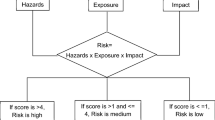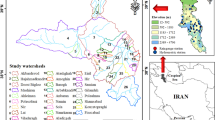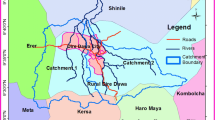Abstract
The recurrent flooding during monsoon and subsequent waterlogging in the northern Bihar plains and the magnitude of losses due to these hazards indicate the continuing vulnerability of the region to flood and waterlogging. Management of floods and waterlogging hazards in highly flood-prone regions of India, including Bihar state has been largely response oriented with little or no attention to mitigation and preparedness. This paper presents a method for spatial, Geographic Information Systems-based assessment of flood and waterlogging vulnerability and risk in northern Bihar plains. Multitemporal satellite data was used to evaluate the area statistics and dynamics of waterlogging over the period from 1975 to 2008. The flood proneness is evaluated at district level with reference to flood inundation during a period from 1998 to 2008. Census data were used to examine the socio-economic characteristics of the region through computation of population density, cultivators, agricultural labourers, sex ratio, children in age group 0–6 years and literates. The geohazard map derived by combining area prone to waterlogging and flood inundation was multiplied with socio-economic vulnerability map to derive the flood-waterlogging risk map of the region. The result shows that flood and water-logging pose highest risk to the central districts in the northern Bihar plains with 50.95% of the total area under high and very high risk.








Similar content being viewed by others
References
Abrol IP (1982) Reclamation of waste lands and world food prospects. In Whither Soil Research, Panel Discussion Papers, 12th International Congress Soil Science, New Delhi, 317–337
Abrol IP, Bhumbla DR (1971) Saline and alkali soils in India- their occurrence and management. World Soil Resources Report No 41-42, Food and Agriculture Organization, Rome
Agarwal A, Narain S (1996) Floods, floodplains and environmental myths. State of India’s environment: a citizen report, Centre for Science and Environment, New Delhi
Ahmad E (1971) The Ganga—a study in river geography. Geographer, vol XVIII. Aligarh Muslim University
Ambastha K, Hussain SA, Badola R (2007) Resource dependence and attitudes of local people toward conservation of Kabartal wetland: a case study from the Indo-Gangetic plains. Wetlands Ecol Manage 15:287–302
Anonymous (1976) Report of the national commission on agriculture, part V, IX and abridged report. Ministry of Agriculture and Irrigation, Government of India, New Delhi
Anonymous (1991) Waterlogging, soil salinity and alkalinity. Report of the Working Group on problem identification in irrigated areas with suggested remedial measures. Technical Report, Ministry of Water Resources, Government of India, New Delhi
Blaikie PM, Cannon T, Davis I, Wisner B, Blaikie P (1994) At risk: natural hazards, people’s vulnerability, and disaster. Routledge, New York
Downing TE, Bakker K (2000) Drought discourse and vulnerability. In: Wilhite DA (ed) Drought: a global assessment, vol. 2. Routledge, London
Dwivedi RS, Sreenivas K (1998) Delineation of salt-affected soils and waterlogged areas in the Indo-Gangetic plains using IRS-1C LISS-III data. Int J Remote Sens 19(14):2739–2751
Dwivedi RS, Sreenivas K, Ramana KV (1999) Inventory of salt-affected soils and waterlogged areas: a remote sensing approach. Int J Remote Sens 20(8):1589–1599
Erenstein O, Hellin J, Chandna P (2010) Poverty mapping based on livelihood assets: a meso-level application in the Indo-Gangetic Plains, India. Appl Geogr 30(1):112–125
Ghosh AK, Bose N, Singh KRP, Sinha RK (2004) Study of spatio-temporal changes in the wetlands of north Bihar through remote sensing. ISCO 2004—13th International Soil Conservation Organisation Conference—Brisbane, July 2004. Conserving Soil and Water for Society: Sharing Solutions. Paper No. 471
Gole CV, Chitale SV (1966) Inland delta building activity of Kosi river. J Hydraul Div, Proc Am Soc Civil Eng 92:111–126
Government of India (2006) Dynamic groundwater resources of India as on March 2004. New Delhi: Ministry of Water Resources, Govt of India
Houghton JT, Ding Y, Griggs DJ, Noguer M, van der Linden PJ, Dai X, Maskell K, Johnson CA (2001) The science of climate change, assessment report of IPCC Working Group I. Cambridge University Press, Cambridge
Ikeda K (1995) Gender differences in human loss and vulnerability in natural disasters: a case study from Bangladesh. Indian J Gender Stud 2(2):171–193
International Fund for Agricultural Development (IFAD) (2003) Rural poverty situation in Gangetic plains: profile, determinants and possible interventions. Report No. 1446-IN
Jain V, Sinha R (2003) River systems in the gangetic plains and their comparison with the Siwaliks: a review. Curr Sci 84(8):1025–1033
Jain V, Sinha R (2004) Fluvial dynamics of an anabranching river system in Himalayan foreland basin, north Bihar Plains, India. Geomorphology 60:147–170
Kale VS (1997) Flood studies in India: a brief review. J Geol Soc India 49:359–370
Kates RW (1985) The interaction of climate and society. In: Kates RW, Ausubel JH, Berberian M (eds) Climate impact assessment: studies of the interaction of climate and society. Wiley, London
Kindscher K, Fraser A, Jakubauskas ME, Debinski DM (1998) Identifying wetland meadows in Grand Teton National Park using remote sensing and average wetland values. Wetlands Ecol Manage 5:265–273
Nain AS, Dadhwal VK, Singh TP (2002) Real time wheat yield assessment using technology trend and crop simulation model with minimal data set. Curr Sci 82(10):1255–1258
National Commission on Agriculture (1976) Report of the National Commission on Agriculture. Part V, IX, Abridged Report. Ministry of Agriculture and Irrigation, New Delhi
Pant GB, Kumar KR (1997) Climates of South Asia. John Wiley, UK, p 320
Prasad SN, Ramchandra TV, Ahalya N, Sengupta T, Kumar A, Tiwari AK, Vijayan VS, Vijayan L (2002) Conservation of wetlands of India—a review. Trop Ecol 43(1):173–186
Rakesh K, Singh RD, Sharma KD (2005) Water resources of India. Curr Sci 89(5):794–811
Saha D, Dhar YR, Vittala SS (2009) Delineation of groundwater development potential zones in parts of marginal Ganga Alluvial Plain in South Bihar, Eastern India. Environ Monit Assess. doi: 10.1007/s10661-009-0937-2
Singh NT (1992) Land degradation and remedial measures with reference to salinity, alkalinity, waterlogging and acidity. In: Deb DL (ed) Natural resources management for sustainable agriculture and environment. Angkor Publisher, New Delhi, India, pp 65–102
Singh RL (1994) India: a regional geography. National Geographical Society of India. UBS Publishers Distribution Limited, India, pp 183–252
Singh N, Sontakke NA (2002) On climatic fluctuations and environmental change of the Indo-Gangetic Plains, India. Clim Change 52:287–313
Sinha R, Jain V (1998) Flood hazards of north Bihar rivers, Indo-Gangetic plains. In: Kale, V. S. (Ed) Flood studies in India, Memoir Geological Society of India 41:27-52
Smith RM (1986) Comparing traditional methods for selecting class intervals on choropleth maps. Prof Geogr 38(1):62–67
Srivastava P, Parkash B, Sehgal JL, Kumar S (1994) Role of neotectonics and climate in development of the Holocene geomorphology and soils of the Gangetic Plains between Ramganga and Rapti rivers. Sediment Geol 94:129–151
Sujatha G, Dwivedi RS, Sreenivas K, Venkataratnam L (2000) Mapping and monitoring of degraded lands in part of Jaunpur district of Uttar Pradesh using temporal spaceborne multispectral data. Int J Remote Sens 21(3):519–531
Swaminathan MS (2001) Food security and sustainable development. Curr Sci 81(8):948–954
Tejwani KG (1987) Watershed Management in the Indian Himalaya, in Perspectives in Environment Management (Chapter 13). Oxford & IBM Publishing Co. Pvt. Ltd, New Delh, pp 203–227
United Nation Development Program (2004) Reducing disaster risk. A challenge for development. United Nation Development Program/Bureau for Crisis Prevention and Recovery, New York
Vaughan M (1987) The story of an African famine: gender and famine in twentieth century Malawi. Cambridge University Press, Cambridge
Wells NA, Dorr JN (1987) Shifting of the Kosi River, Northern India. Geology 15:204–207
Wilhelmi OV, Wilhite DA (2002) Assessing vulnerability to agricultural drought: a Nebraska case study. Nat Hazards 25:37–58
Wilhite DA (2000) Drought as a natural hazard: concepts and definitions. In: Wilhite DA (ed) Drought: a global assessment. Hazards and disasters: a series of definitive major works. Routledge Publishers, London
World Bank (1998) India-water resource management, sector review. New Delhi: Rural Development Unit, South Asia Region
Author information
Authors and Affiliations
Corresponding author
Rights and permissions
About this article
Cite this article
Pandey, A.C., Singh, S.K. & Nathawat, M.S. Waterlogging and flood hazards vulnerability and risk assessment in Indo Gangetic plain. Nat Hazards 55, 273–289 (2010). https://doi.org/10.1007/s11069-010-9525-6
Received:
Accepted:
Published:
Issue Date:
DOI: https://doi.org/10.1007/s11069-010-9525-6




